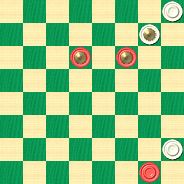The Long Road Home

It's Thanksgiving Weekend in the United States, a very special and very American holiday, and a weekend on which many people travel long distances to be home with family. Whether you've been able to stay close by, or have yourself journeyed on that long road home, The Checker Maven wishes you the all best of this, our favorite holiday by any measure.
For Thanksgiving Weekend, we bring you a special installment of Checker School with an instructive pair of situations from Ben Boland's classic reference, Famous Positions in the Game of Checkers. Here's the first one, and it illustrates today's theme of traveling far to reach your goal:
WHITE

BLACK
Black to Play and Win
B:W29,K25,5:BK23,K22,1.
Black can win this position, just barely, but it requires a lot of clever maneuvering and a good dose of patience. Are you methodical enough to work it out? Can you visualize far enough ahead to find the solution without moving pieces on a board? It's quite a challenge, and indeed a long road home.
Here is a much easier one, which arises from a variant of the tougher one above:
WHITE

BLACK
Black to Play and Win
B:W17,5:BK10,1.
The solution is very neat and not all that difficult to find. Can you do it?
Whether you in fact find your way, or remain lost, clicking on Read More will guide you on the path to Ben Boland's solution, descriptive notes, example games, and entertaining comments.![]()
Solutions
Diagram No. 1: 23-18, 25-21, 18-14, 21-25, 22-17, 25-30---A, 17-21, 30-26, 14-17,26-23, 17-22, 23-19, 21-17, 19-15, 17-14, 15-19, 14-18, 19-24, 18-23, 24-28, 22-18, 28-24, 18-15, 24-28, 15-19, 28-32, 19-24, 32-28, 23-19, 28-32, 24-28, 32-27, 28-32, 27-31, 19-23, 31-27, 23-18, 27-24, 18-15. 29-25---i, 32-28, 24-27, 15-18, 27-32, 18-23, 25-22, 28-24 32-28, 24-19, 28-32, 23-26, 22-17, 26-22, 17-13---ii, 22-18---iii. Black Wins.
Diagram No. 2: (Off Note A) 10-7*, 17-14, 1-6, 5-1, 6-9, 14-5, 7-10 Black Wins.
Game: 11-15, 23-19, 8-11, 22-17, 9-13, 17-14, 10-17, 21-14, 15-18, 26-23, 13-17, 19-15, 4-8, 24-19, 6-9, 28-24, 2-6, 25-21, 9-13, 32-28, 17-22, 15-10, 6-15, 19-10, 11-15, 24-19, 15-24, 28-19, 7-11, 30-25---B, 11-16, 21-17, 5-9, 14-5, 8-11, 23-14, 16-32, 25-18, 13-22, 14-9, 32-28, 9-6, 28-24, 6-2, 12-16, 10-7---C, 3-10, 2-7, 10-15, 7-10, 24-19, 10-14, 16-20, 14-10, 20-24, 31-26, 22-31, 10-7, 15-22, 7-23---D, 24-28, 23-26, 28-32, 26-17, 32-27, 17-22---E, 27-23, 22-25, 31-26, 25-30, 26-22, 30-25. Forms above position. Diagram No. 1, R. E. Bowen.
The following irregular game leads to same position colors reversed.
Game: 11-15, 23-19, 10-14, 19-10, 6-15, 22-17, 8-11, 17-10, 7-14, 25-22, 2-7, 22-17, 7-10, 17-13, 1-6, 26-22, 3-7, 24-19, 15-24, 28-19, 11-15, 27-24, 15-18, 22-15, 12-16, 19-12, 10-28, 29-25, 14-17, 21-14, 9-18, 30-26, 5-9, 31-27, 9-14, 26-23, 6-10---F, 13-9, 14-17, 23-14, 17-21, 9-6, 10-17, 6-2, 21-30, 2-11, 30-26, 12-8, 26-22, 8-3, 17-21, 3-8, 21-25, 8-12, 25-30, 11-16, 30-25, 16-19, 25-30, 19-23, 30-25, 27-24, 25-21, 24-19, 21-17, 19-15, 17-14, 15-11, 22-18, 23-19, 14-10, 12-8, 18-15, 19-23, 10-14, 8-12, 15-8, 12-3, 14-9, 23-18, 9-6, 18-14, 6-1, 3-7, 1-5, 7-10, 5-1, 14-9, 1-5, 10-14, 5-1, 9-5, 1-6, 5-1, 6-2, 14-18---G, 2-7, 1-6, 7-11, 6-10, 11-8-H, 10-7, 8-3, 7-11, 3-8. Forms above position. Diagram No. 1, colors reversed, with 23 on 15. J. P. Grey and P. Thirkell.
A---25-21, 14-9, 21-14, 9-18, 29-25, 18-14, 25-21 (25-22) 1-6. Black Wins. This is No. 8 Janvier's Sturges, colors reversed, but 1-6 can win by "First Position," and 14-10, 21-17. Forms Diagram No. 2.
B---Janvier's "Anderson" shows 14-9 and 21-17 to draw.
C---Harper Colthard in Nov. 1, 1869, Draught Board (old series), gave the above move to correct Anderson who played 2-6 here. Variation 76, 17th move Anderson's Guide, 1852, var. 53 in Janvier's.
D---Here Colthard left the game as drawn. Bowen then gave it as No. 67, Jan. 1, 1870 issue of the Draughts Board.
E---29-25, 27-23, 25-22, 23-19, 22-18, 31-26, etc. Black Wins.
F---Grey shows 7-10 to draw.
G---To here by J. P. Grey, Draughts World, Oct.-Dec. 1908, Vol. 32; 14-10 2-6 10-7, 6-9, 7-2, 4-8, 1-5. White Wins.
H---Grey left it here as drawn. P. Thirkell in Draughts World, vol. 33, Jan. 1909, shows the above win. R. E. Bowen in Draught Board, Jan. 1, 1870, wrote in a letter to the Editor dated Nov. 29, 1869; on the 11th of January, 1869, Mr. Drummond published a game in the N. Y. "Turf," purporting to be a correction of Anderson's Laird and Lady Game, var. 76, again in the November issue of the Draught Board, Page 76, I find the same supposed correction by Mr. Colthard. I hope the subjoined play on the position enclosed will meet with the approbation of the above named gentlemen, and show that Anderson is still correct.
The above position (Diagram No. 1) may also be found by J. Wyllie, No. 459 Gould's Problem Book, colors reversed, with this note: When the solution to this position was published in the Glasgow Herald, the editor said, uWe have to mention a rather unusual coincidence in connection with the above position. On Friday last (no date given) we received a position precisely similar from Mr. D. Gourlay, who mentioned that it had occurred a night or two previously in a 'Bristol' game he played with Mr. J. King.
Sturges' position may be found in his Critical Situations as No. 8, colors reversed, at 2nd move, and man on 5 a king.
i---The man on 29 finally has to move, being held back as long as possible up to now. ---Ed.
ii---17-14, 19-15 Black Wins. The man on 14 will fall. ---Ed.
iii---The two Black Kings will go after the lone White King in the double corner. Eventually, to save his King, White will have to move the man on 13, first to 9 and then ultimately to 6, right into the jaws of the Black man on 1, who has seemingly waited with patience for the entire game for his moment of glory. ---Ed.
Note in Diagram No. 1: If the move were different the white man on 29 can come through in safety.
The Origin of "Cook." An exchange attributes the origin of the word "Cook," to taking his "raw ideas" of End Games. "I will cook their new idea." He thinks the only term used was in the sense of "improve" or "render more presentable." The use of the word for finding two solutions to a problem has always appeared inappropriate. The process of "Improvement" naturally entails the elimination of all errors, dual keys, etc., and it may be that in the course of time the word "Cook" gradually came into use to denote a search for flaws, of which dual keys are the type, and then later to denote the discovery of such flaws requiring removal. The word "Cook," if somewhat inaccurate, it is at least expressive. ---The Draughts World.
You can email the Webmaster with comments on this article.